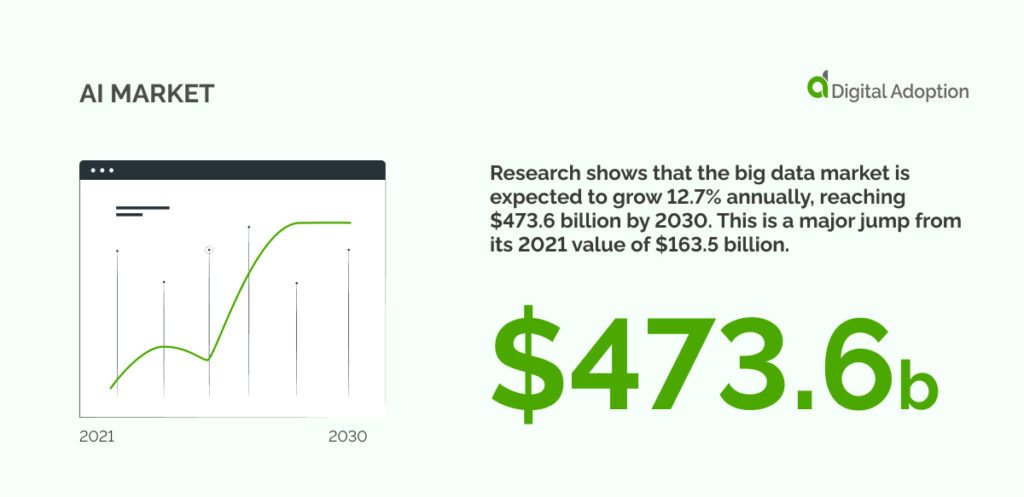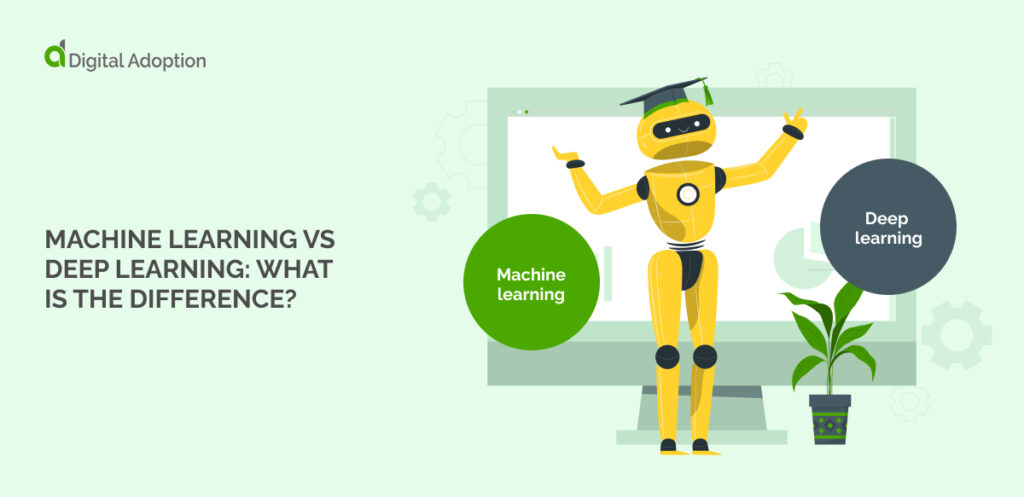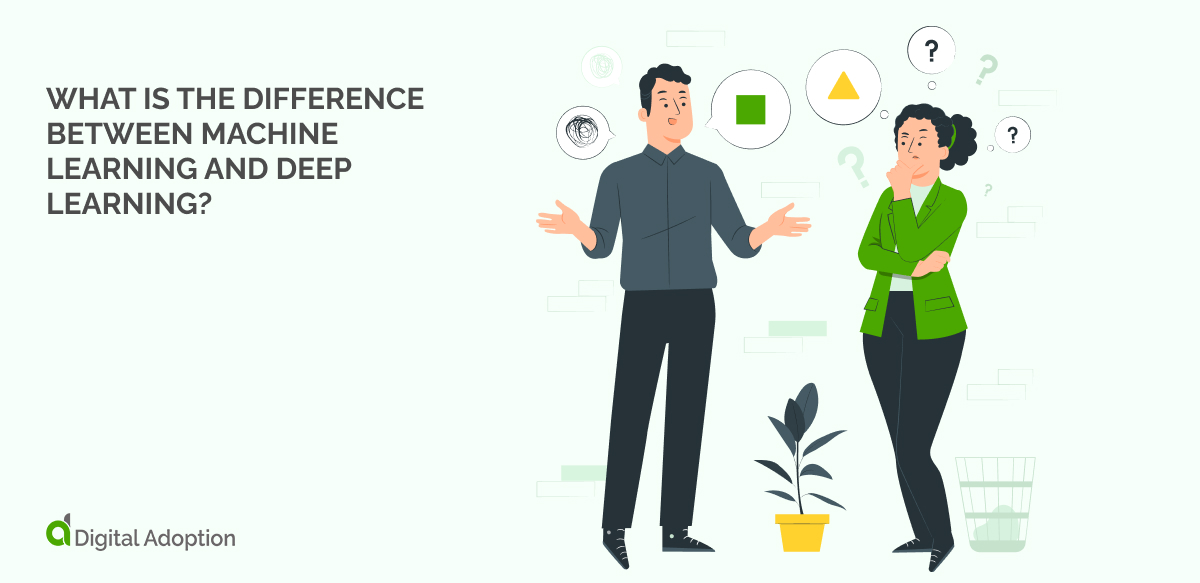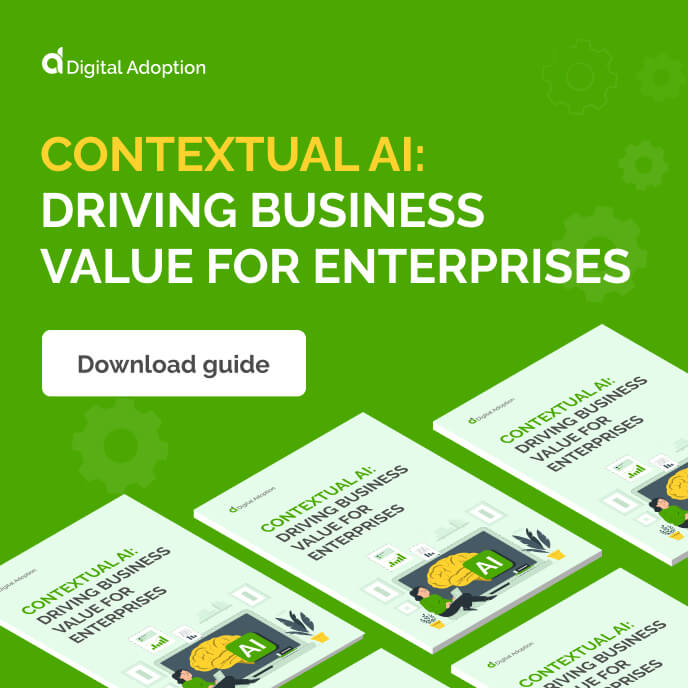No longer a distant possibility reserved for futuristic sci-fi novels, AI is reshaping the world around us.
Artificial intelligence models can perform at the same speed and complexity as humans. In healthcare, AI analyzes decades of patient data to detect diseases earlier. In pharmaceuticals, AI can simulate drug trials and discover new life-saving medicines.

Research shows that the big data market is expected to grow 12.7% annually, reaching $473.6 billion by 2030. This is a major jump from its 2021 value of $163.5 billion.
So what can be done with all this data? Enter machine learning (ML) and deep learning (DL). These subsets of AI underpin big data. The ability to handle additional data will result in more sophisticated AI.
More data requires more intricate methods for handling it. This article will explore machine learning (ML) vs. deep learning (DL). We’ll provide a definition and highlight the differences between them. We’ll also share some examples of how these two distinct yet interconnected fields of AI work best in tandem.
What is machine learning?
Machine learning (ML) is the practice of teaching computer systems to perform intelligent actions by learning from data. ML algorithms combine and sort input data to understand and make targeted outputs.
ML and DL create systems that learn by processing information through layers of connected units. These algorithmic layers combine to make smarter AI solutions capable of handling huge amounts of data.
Once developed, ML algorithms can mature into machine learning models. These models make up complete AI solutions trained to perform tasks without pre-programmed instructions. Uses for these solutions include pattern recognition, statistical forecasting, and decision-making capabilities.
What is deep learning?
Deep learning comprises a network of interconnected algorithms layered on top of one another. These algorithms combine to create neural networks inspired to function similarly to the human brain.
These nodes can handle, exchange, and transform huge amounts of data. The complexity and quantity of this data ask DL techniques to do the legwork.
Machine learning (ML) relies on specific algorithms for tasks. Deep learning (DL) builds on this by creating more intricate structures called artificial neural networks. These networks work together simultaneously. This allows them to tackle complex problems that might be beyond simpler ML algorithms.
What is the difference between machine learning and deep learning?
Within the study of machine learning sits deep learning. These fields are both a subset of artificial intelligence (AI). While ML and DL can create intelligent systems, DL’s strength lies in completing tasks involving intricate data.
Let’s break down their differences in the chart below to understand this better.
| Key Specifications | Machine Learning | Deep Learning |
| Output Type | ML provides specific classifications, such as identifying and labeling data. It generates numerical predictions (e.g., stock price) and recommends items based on user behavior and historical data | Recognizes objects and generates descriptions (e.g., identifying clouds in a photo), translates languages, creates realistic images or text formats, and makes complex decisions by combining multiple factors and predictions |
| Data Availability | Can be effective with 100s to 1000s of data points (structured, clear patterns), often leverages domain-specific features | Requires millions or even billions of labeled data points for optimal performance, benefits from large datasets with diverse examples |
| Task Complexity | Wins at tasks with well-defined rules and patterns and identifies trends in data with clear mathematical models. These are commonly used for functions with a predefined set of possible outcomes | Tackles problems with hidden or intricate patterns and uncovers complex relationships within data. DL is well-suited for tasks requiring nuanced understanding and data interpretation |
| Resources & Model Size | Models are generally smaller and require less computational power for training and operation | Models are larger and require more computational resources (training often involves powerful computers or cloud-based systems with GPUs). The larger complexity of DL can limit deployment to specific hardware environments |
| Training Data Type | Primarily works with structured data (numerical data or text converted into numerical representations). ML may require feature engineering to prepare data for specific algorithms | Handles a wider variety of data types (structured, semi-structured like log files, unstructured like images, audio, and natural language text) |
| Industry Use Case Domains | Widespread applications: fraud detection (financial transactions), spam filtering (email systems), customer churn prediction (telecom companies), recommendation systems (online shopping) | Areas demanding complex pattern recognition and analysis: self-driving cars (image recognition), medical diagnosis support (analyzing medical scans), chatbots (natural language processing), content creation (generating realistic images or videos) |
| Developmental Expertise | Requires programming skills and understanding of specific algorithms (e.g., decision trees, linear regression), more accessible for beginners with open-source libraries and tools | Requires specialized knowledge in neural networks and deep learning architectures (e.g., convolutional neural networks, recurrent neural networks), often involves higher levels of programming expertise and familiarity with deep learning frameworks like TensorFlow or PyTorch, expertise in data science and machine learning is often a prerequisite |
| Ethics & Privacy | Models can inherit biases in the training data, leading to unfair predictions (e.g., biased loan approvals). Mitigating bias requires careful consideration during data selection, model development, and fairness evaluation | The complexity of deep learning models can make them more prone to bias due to the “black box” nature where the internal decision-making process is less transparent |
Examples of how machine learning and deep learning work together
When combined, machine learning (ML) and deep learning (DL) work best to create expert AI technology. ML provides the foundation, while DL layers these processes for advanced tasks.
ML and DL, in tandem, present far-reaching potential industry-wide. Entire business models can be transformed through the emergence of intelligent technology. Processes can be reimagined, along with heightened productivity and efficiency.
Let’s explore how ML and DL work best when used in combination.
Image recognition and object detection
In security systems, ML acts as an automated set of eyes. These models can be taught to identify basic shapes and movements in camera footage. DL then steps in, recognizing specific objects like cars or people, even those with poor visibility.
This collaboration allows self-driving vehicles to “see” the road and security systems to pinpoint suspicious activity.
For instance, imagine a security camera overlooking a large parking lot. An ML algorithm might initially flag any movement detected in the frame. DL can then analyze this movement further, differentiating between a person walking through the lot and a car driving by.
This reduces the number of false alarms human operators need to sift through and allows for a faster response to genuine security threats.
Natural Language Processing (NLP)
ML is crucial in NLP because it prepares text data and identifies patterns. While ML excels at tasks like text cleaning, tokenization, and recognizing basic word relationships, it often struggles with the complexities of human language.
This is where deep learning (DL) takes center stage. DL tackles more complex tasks like contextualization and understanding the nuances of language. Analyzing vast amounts of text data, DL models can learn complex grammar rules, accurately translate languages, and even distinguish between specific contexts, like sarcasm or humor.
This highlights the capabilities of popular chatbots like ChatGPT and Google Gemini. These chatbots leverage the power of DL to answer an array of queries and hold fluid conversations. They can comprehend voice commands regardless of accents and adapt their responses based on the ongoing discussion, making them seem more natural and engaging.
Fraud detection in financial services
ML is capable of automatically detecting fraud and anomalous activity. It can determine customer spending habits and detect unusual patterns across transactions. DL takes it a step further, working below the surface. It can explore hidden connections between seemingly unrelated data points. This allows them to identify sophisticated fraud attempts that might slip past traditional cybersecurity methods.
However, it’s difficult to completely trust the model’s autonomous discovery of hidden connections without human oversight and validation. Understanding the rationale behind the model’s flags in critical situations is important. Explainable AI techniques can help data analysts interpret the model’s reasoning and ensure its alignment with real-world fraud patterns.
Disease diagnosis and drug discovery in healthcare
ML algorithms are valuable tools for medical diagnosis, particularly in image analysis. ML can highlight potential areas of concern by identifying recurring patterns within X-ray data. This streamlines the diagnostic process for healthcare professionals, allowing them to focus on the intricacies of each case.
DL extends this functionality by offering superior pattern recognition capabilities. DL excels at detecting subtle anomalies in X-rays that traditional methods may miss. This enhanced precision can lead to earlier diagnoses and improved patient outcomes.
The combined power of ML and DL enables significant advancements in healthcare. These technologies ease the analysis of vast datasets with unparalleled accuracy, impacting both diagnostic processes and drug discovery efforts. This paves the way for developing more personalized and targeted treatment approaches.
Tailored recommendations
Modern e-commerce platforms use advanced ML and DL to deliver personalized customer experience. ML analyzes past purchase behavior to identify patterns and preferences. This enables targeted product recommendations that align with established buying habits.
DL extends beyond simple recommendations, analyzing user browsing behavior to detect emerging interests. Deep learning (DL) can help customers understand their browsing patterns. This allows it to recommend products they’ve shown interest in, even if not explicitly purchased. This combined approach enables enhanced relevancy. Customers can get product recommendations that resonate with their individual needs.
It can also increase engagement by keeping customers on the platform for longer. Providing relevant and timely recommendations improves customer satisfaction, resulting in a more positive shopping experience.
Speech recognition and text-to-speech
Speech recognition technology relies on a combination of machine learning (ML) and deep learning (DL) techniques. ML is the foundation for analyzing vast amounts of speech data to understand the core components of spoken language. This includes identifying phonemes, pronunciations, and common sentence structures. Essentially, ML equips the system with a comprehensive understanding of fundamental spoken words.
However, human speech is multifaceted. Deep learning takes over to address these complexities. With advanced algorithms, DL accounts for variations in speech patterns, accents, and even background noise. This ensures the system can accurately recognize speech. Even when speakers have different speaking styles, regional dialects, or speak less-than-ideal environments.
The synergy between ML and DL creates a robust speech recognition engine. This technology underpins various applications critical to modern businesses. These include voice-activated virtual assistants, dictation software, and interactive voice response (IVR) systems.
Machine learning vs. Deep learning: The verdict

Machine learning and deep learning have a symbiotic relationship.
Machine learning provides the foundation. It encompasses various algorithms that enable computers to learn from data. Deep learning uses artificial neural networks to process information and identify intricate patterns.
This capability allows deep learning to excel in tasks involving vast amounts of unstructured data. These often include images, text, and speech.
Businesses are taking advantage of this connected ecosystem and pioneering new ways to innovate. Machine learning algorithms are already automating business processes and generating data-driven predictions.
Deep learning refines these capabilities by uncovering hidden insights within complex data sets. This helps businesses develop targeted marketing strategies and optimize product development lifecycles.
When employed strategically, ML and DL provide businesses a significant competitive advantage in a data-driven marketplace.




![4 Best AI Chatbots for eCommerce [2025]](https://www.digital-adoption.com/wp-content/uploads/2025/03/4-Best-AI-Chatbots-for-eCommerce-2025-img-300x146.jpg)


![13 Digital Transformation Enablers [2025]](https://www.digital-adoption.com/wp-content/uploads/2025/02/13-Digital-Transformation-Enablers-2025-img-300x146.jpg)



![4 Best AI Chatbots for eCommerce [2025]](https://www.digital-adoption.com/wp-content/uploads/2025/03/4-Best-AI-Chatbots-for-eCommerce-2025-img.jpg)

